List of rulers of Bengal
This is a list of rulers of Bengal. For much of its history, Bengal was split up into several independent kingdoms, completely unifying only several times. In ancient times, Bengal consisted of the kingdoms of Pundra, Suhma, Vanga, Samatata and Harikela.
In the 4th century BCE, during the reign of the Nanda Empire, the powerful Gangaridai rulers of sent their forces with the war elephants which led the withdrawal of Alexander the Great from the Indian subcontinent.
As a province of the Mauryan Empire, much of Bengal was part of it except for the far eastern Bengali kingdoms which maintained friendly relationships with Ashoka. The kingdoms of Bengal continued to exist as tributary states before succumbing to the Guptas. With the fall of the Gupta Empire, Bengal was united under a single local ruler, King Shashanka, for the first time. With the collapse of his kingdom, Bengal split up into petty kingdoms once more.
With the rise of Gopala in 750 AD, Bengal was united once more under the Buddhist Pala Empire until the 12th century than being succeeded by the Hindu Chandra dynasty, Sena dynasty and deva dynasty. After them, Bengal was ruled by the Hindu Maharajas of kingdoms such as Chandradwip and Cooch Behar.
After the Muslim conquests in the Indian subcontinent, Bengal was ruled by Muhammad bin Bakhtiyar Khalji, under whom Indian Islamic missionaries achieved their greatest success in terms of dawah and number of converts to Islam, which caused the decline of Buddhism.[1][2] The Islamic Mamluk Sultanate, the Khalji dynasty, the Turko-Indian Tughlaq dynasty, the Sayyid dynasty and the Lodi dynasty ruled Bengal for over 320 years.[3] Notable was Malik Altunia's reign with his wife Razia Sultana, the only female sovereign ruler.
Following Delhi Sultanate's reign, the Bengal Sultanate, a major trading nation in the world,[4] was founded by Shamsuddin Ilyas Shah, and ruled by the Ilyas Shahi dynasty, succeeded by the Hussain Shahi dynasty founded by Alauddin Husain Shah, which saw the extension of the sultanate to the port of Chittagong, witnessing the arrival of the earliest Portuguese merchants.
After being absorbed to the Bengal Subah by Babur in the 16th century during the defeat of Sultan Nasiruddin Nasrat Shah in the Battle of Ghaghra, Bengal became the most economically advanced region in the world,[5][6][7] and started to be ruled by the Subahdars of the Mughal Empire. Emperor Akbar developed the Bengali Calendar and began to preach the newly invented religion of Din-i Ilahi, which was declared by the Qadi of Bengal to be a blasphemy. Islam Khan I declared Dhaka as the capital of Bengal, which was then known as Jahangir Nagar, renamed after emperor Jahangir. The reign of prince Shah Shuja under emperor Shah Jahan's orders represented the height of Mughal architecture. During the period of proto-industrialization, when Bengal was ruled by emperor Aurangzeb's relatives such as Subedar Shaista Khan, Muhammad Azam Shah, and Azim-ush-Shan, the region was fully ruled through Fatwa Alamgiri, a hybrid body of Hanafi law based on sharia and was controversially described as the Paradise of the Nations.[8]
After the decline of the Mughal Empire, the Nawabs of Bengal and Murshidabad ruled over Bengal and Odisha. Nawab Alivardi Khan came victorious against the Maratha Empire in the battle of Battle of Burdwan. Following the Battle of Plassey and the execution of Siraj ud-Daulah, the East India Company formally established control over Bengal, and the Bengal Presidency was established by Robert Clive, with the subdivision remaining the economic, cultural and educational hub of the Company and the Raj.
The position of the Prime Minister of Bengal was established in 1937, being held by A. K. Fazlul Huq and Huseyn Shaheed Suhrawardy. After the Indian independence movement and Partition of Bengal (1947), the West Bengal became a major state of the Republic of India, while the Muslim majority East Bengal became known as East Pakistan. In 1971 East Bengal became an independent nation, Bangladesh, following the Bangladesh Liberation War, governed by Sheikh Mujibur Rahman, Ziaur Rahman and Hussain Muhammad Ershad.
Legendary kings of Magadha: Brihadratha Dynasty (c. 1700–799 BCE)
- Brihadratha
- Jarasandha
- Sahadeva of Magadha
- Somadhi (1679–1618 BCE)
- Srutasravas (1618–1551 BCE)
- Ayutayus (1551–1515 BCE)
- Niramitra (1515–1415 BCE)
- Sukshatra (1415–1407 BCE)
- Brihatkarman (1407–1384 BCE)
- Senajit (1384–1361 BCE)
- Srutanjaya (1361–1321 BCE)
- Vipra (1321–1296 BCE)
- Suchi (1296–1238 BCE)
- Kshemya (1238–1210 BCE)
- Subrata (1210–1150 BCE)
- Dharma (1150–1145 BCE)
- Susuma (1145–1107 BCE)
- Dridhasena (1107–1059 BCE)
- Sumati (1059–1026 BCE)
- Subhala (1026–1004 BCE)
- Sunita (1004–964 BCE)
- Satyajit (964–884 BCE)
- Biswajit/Biswas (884–849 BCE)
- Ripunjaya (849–799 BCE)
Pre-Pala dynasties
Haryanka Dynasty (568–413 BCE)
Shishunaga Dynasty (413–345 BCE)
- Shishunaga (413–395 BCE)
- Kakavarna (395–367 BCE)
- Mahanandin (367-345 BCE)
Nanda Dynasty (345–321 BCE)
- Mahapadma Nanda (also known as Ugrasena according to Buddhist texts) (from 345 BCE)
- Pandhuka
- Panghupati
- Bhutapala
- Rashtrapala
- Govishanaka
- Dashasidkhaka
- Kaivarta
- Dhana Nanda (Agrammes, Xandrammes) (until 321 BCE)
Maurya Dynasty (324–185 BCE)
- Chandragupta Maurya (Sandrakottos) (324–301 BCE)
- Bindusara Amitraghata (301–273 BCE)
- Ashoka Vardhana (Ashoka the Great) (273–232 BCE),
- Dasharatha (232–224 BCE)
- Samprati (224–215 BCE)
- Shalishuka (215–202 BCE)
- Devavarman (202–195 BCE)
- Shatadhanvan (195–187 BCE)
- Brihadratha (187–184 BCE)
Shunga Dynasty (185–73 BCE)
- Pushyamitra Shunga (185–149 BCE)
- Agnimitra (149–141 BCE)
- Vasujyeshtha (141–131 BCE)
- Vasumitra (131–124 BCE)
- Andhraka (124–122 BCE)
- Pulindaka (122–119 BCE)
- Ghosha
- Vajramitra
- Bhagabhadra
- Devabhuti (83–73 BCE)
Kanva Dynasty (73–43 BCE)
- Vasudeva Kanva (from 73 BCE)
- Bhumimitra
- Narayana
- Susharman (Until 43 BCE)
Gupta Empire (c. CE 240–550 )
- Sri-Gupta I (c. 240–280)
- Ghatotkacha (280–319)
- Chandra Gupta I (320–335)
- Samudra Gupta (335–380)
- Rama Gupta (?)
- Chandra Gupta II (Chandragupta Vikramaditya) (380–413/415)
- Kumara Gupta I (415–455)
- Skanda Gupta (455–467)
- Puru Gupta(467-473)
- Kumara Gupta II (473–476)
- Buddha Gupta (476–495)
- Narasimha Gupta(495-?)
- Kumara Gupta III (?)
- Vishnugupta (540–550)
- Vainya Gupta (550–?)
- Bhanu Gupta(?)
Khadga kingdom
The Khadga dynasty was a line of Buddhist kings that ruled the areas of Vanga and later Samatata (modern Bangladesh).[9]
- Khadgodyama (625–640)
- Jatakhadga (640–658)
- Devakhadga (658–673)
- Rajabhata (673–690)
- Balabhata (690–705)
- Udirnakhadga (undetermined reign)
Mallabhum
Mallabhum was the kingdom ruled by the Mallas kings of Bishnupur primarily in the present Bankura district in the Indian state of West Bengal.[10][11][12]
- Adi Malla (694 - 710)
- Jay Malla (710 - 720)
- Benu Malla (720 - 733)
- Kinu Malla (733 - 742)
- Indra Malla (742 - 757)
- Kanu (Kau/Kalu) Malla (757 - 764)
- Dha (Jhau) Malla (764 - 775)
- Shur Malla (775 - 795)
- Kanak Malla (795 - 807)
- Kandarpa Malla (807 - 828)
- Sanatan Malla (828 - 841)
- Kharga Malla (841 - 862)
- Durjan (Durjay) Malla (862 - 906)
- Yadav Malla (906 - 919)
- Jagannath Malla (919 - 931)
- Birat Malla (931 - 946)
- Mahadev Malla (946 - 977)
- Durgadas Malla (977 - 994)
- Jagat Malla (994 - 1007)
- Ananta Malla (1007 - 1015)
- Rup Malla (1015 - 1029)
- Sundar Malla (1029 - 1053)
- Kumud Malla (1053 - 1074)
- Krishna Malla (1074 - 1084)
- Rup II (Jhap) Malla (1084 - 1097)
- Prakash Malla (1097 - 1102)
- Pratap Malla (1102 - 1113)
- Sindur Malla (1113 - 1129)
- Sukhomoy(Shuk) Malla (1129 - 1142)
- Banamali Malla (1142 - 1156)
- Yadu/Jadu Malla (1156 - 1167)
- Jiban Malla (1167 - 1185)
- Ram(Kshetra) Malla (1185 - 1209)
- Gobinda Malla (1209 - 1240)
- Bhim Malla (1240 - 1263)
- Katar(Khattar) Malla (1263 - 1295)
- Prithwi Malla (1295 - 1319)
- Tapa Malla (1319 - 1334)
- Dinabandhu Malla (1334 - 1345)
- Kinu/Kanu Malla II (1345 - 1358)
- Shur Malla II (1358 - 1370)
- Shiv Singh Malla (1370 - 1407)
- Madan Malla (1407 - 1420)
- Durjan Malla (1420 - 1437)
- Uday Malla (1437 - 1460)
- Chandra Malla (1460 - 1501)
- Bir Malla (1501 - 1554)
- Dhari Malla (1554 - 1565)
- Hambir Malla Dev (1565 - 1620)
- Dhari Hambir Malla Dev (1620 - 1626)
- Raghunath Singha Dev (1626 - 1656)
- Bir Singha Dev (1656 - 1682)
- Durjan Singha Dev(1682 - 1702)
- Raghunath Singha Dev II (1702 - 1712)
- Gopal Singha Dev (1712 - 1748)
- Chaitanya Singha Dev (1748 - 1801)
- Madhav Singha Dev (1801 - 1809)
- Gopal Singha Dev II (1809 - 1876)
- Ramkrishna Singha Dev (1876 - 1885)
- Dwhajamoni Devi (1885 - 1889)
- Nilmoni Singha Dev (1889 - 1903)
- No King (1903 - 1930)
- Kalipada Singha Thakur (1930 - 1983)
Pala and post-Pala dynasties
Pala Empire
Most of the Pala inscriptions mention only the regnal year as the date of issue, without any well-known calendar era. Because of this, the chronology of the Pala kings is hard to determine.[13] Based on their different interpretations of the various epigraphs and historical records, different historians estimate the Pala chronology as follows:[14]
| RC Majumdar (1971)[15] | AM Chowdhury (1967)[16] | BP Sinha (1977)[17] | DC Sircar (1975–76)[18] | D. K. Ganguly (1994)[13] | |
|---|---|---|---|---|---|
| Gopala I | 750–770 | 756–781 | 755–783 | 750–775 | 750–774 |
| Dharmapala | 770–810 | 781–821 | 783–820 | 775–812 | 774–806 |
| Devapala | 810–c. 850 | 821–861 | 820–860 | 812–850 | 806–845 |
| Mahendrapala | NA (Mahendrapala's existence was conclusively established through a copper-plate charter discovered later.) | 845–860 | |||
| Shurapala I | 850–853 | 861–866 | 860–865 | 850–858 | 860–872 |
| Vigrahapala I | 858–60 | 872–873 | |||
| Narayanapala | 854–908 | 866–920 | 865–920 | 860–917 | 873–927 |
| Rajyapala | 908–940 | 920–952 | 920–952 | 917–952 | 927–959 |
| Gopala II | 940–957 | 952–969 | 952–967 | 952–972 | 959–976 |
| Vigrahapala II | 960–c. 986 | 969–995 | 967–980 | 972–977 | 976–977 |
| Mahipala I | 988–c. 1036 | 995–1043 | 980–1035 | 977–1027 | 977–1027 |
| Nayapala | 1038–1053 | 1043–1058 | 1035–1050 | 1027–1043 | 1027–1043 |
| Vigrahapala III | 1054–1072 | 1058–1075 | 1050–1076 | 1043–1070 | 1043–1070 |
| Mahipala II | 1072–1075 | 1075–1080 | 1076–1078/9 | 1070–1071 | 1070–1071 |
| Shurapala | 1075–1077 | 1080–1082 | 1071–1072 | 1071–1072 | |
| Ramapala | 1077–1130 | 1082–1124 | 1078/9–1132 | 1072–1126 | 1072–1126 |
| Kumarapala | 1130–1125 | 1124–1129 | 1132–1136 | 1126–1128 | 1126–1128 |
| Gopala III | 1140–1144 | 1129–1143 | 1136–1144 | 1128–1143 | 1128–1143 |
| Madanapala | 1144–1162 | 1143–1162 | 1144–1161/62 | 1143–1161 | 1143–1161 |
| Govindapala | 1155–1159 | NA | 1162–1176 or 1158–1162 | 1161–1165 | 1161–1165 |
| Palapala | NA | NA | NA | 1165–1199 | 1165–1200 |
Note:[14]
- Earlier historians believed that Vigrahapala I and Shurapala I were the two names of the same person. Now, it is known that these two were cousins; they either ruled simultaneously (perhaps over different territories) or in rapid succession.
- AM Chowdhury rejects Govindapala and his successor Palapala as the members of the imperial Pala dynasty.
- According to BP Sinha, the Gaya inscription can be read as either the "14th year of Govindapala's reign" or "14th year after Govindapala's reign". Thus, two sets of dates are possible.
Chandra Dynasty
- Traillokyachandra (900–930)
- Srichandra (930–975)
- Kalyanachandra (975–1000)
- Ladahachandra (1000–1020)
- Govindachandra (1020–1050)
Chola dynasty
- Rajendra Chola I (1019-1024)
Sena dynasty
- Hemanta Sena (1070–1096)
- Vijaya Sena (1096–1159)
- Ballala Sena (1159–1179)
- Lakshmana Sena (1179–1206)
- Vishvarupa Sena (1206–1225)
- Keshava Sena (1225–1230)
Deva Dynasty
- Purushottamadeva
- Madhusudanadeva
- Vasudeva
- Damodaradeva (1231–1243)
- Dasharathadeva (1281)
Delhi sultanates era
Khalji dynasty under Delhi (1204-1227)
The Khalji governors of Bengal were at times independent, and at times subordinate to the Delhi Sultanate.
| Name | Reign | Notes |
|---|---|---|
| Muhammad bin Bakhtiyar Khalji | 1204–1206 | Began the Khalji dynasty |
| Muhammad Shiran Khalji | 1206–1208 | |
| Ghiyasuddin Iwaj Shah Khalji | 1208–1210 | |
| Ali Mardan Khalji | 1210–1212 | |
| Ghiyasuddin Iwaj Shah Khalji | 1212–1227 | second term as Husamuddin Iwaj Khalji, killed for gaining independence from Sultan of Delhi Iltutmish |
| Nasiruddin Mahmud | 1227–1229 | Not from the Khalji tribe, appointed by his father Iltutmish |
| Alauddin Daulat Shah Khalji | 1229–1230[19] | |
| Malik Balkha Khalji | 1230–1231 | Last Khalji ruler |
Governors of Bengal under Mamluk Sultanate (1227–1281)
| Name | Reign | Notes |
|---|---|---|
| Alauddin Jani | 1232–1233 | |
| Saifuddin Aibak | 1233–1236 | |
| Awar Khan Aibak | 1236 | Usurper |
| Tughral Tughan Khan | 1236–1246 | Restored Mamluk governor |
| Tughlaq Tamar Khan | 1246–1247 | |
| Jalaluddin Masud Jani | 1247–1251 | |
| Malik Ikhtiyaruddin Iuzbak | 1251–1257 | Claimed independence. |
| Ijjauddin Balban Iuzbaki | 1257–1259 | |
| Tatar Khan | 1259–1268 | Claimed independence. |
| Sher Khan | 1268–1272 | |
| Amin Khan | 1272–1272 | |
| Tughral Tughan Khan | 1272–1281 | Second term as Mughisuddin Tughral |
| Nasiruddin Bughra Khan | 1281-1287 | Governor of Lakhnauti |
Balban dynasty (Independent Lakhnauti kingdom)
| Name | Reign | Notes |
|---|---|---|
| Nasiruddin Bughra Khan | 1287–1291 | Declared independence |
| Rukunuddin Kaikaus | 1291–1300 | First Muslim ruler to conquer Satgaon kingdom, expanding Lakhnauti. |
| Shamsuddin Firoz Shah | 1300–1322 | First Muslim ruler to conquer Sonargaon, Mymensingh and Srihatta. Completed Kaikaus' Conquest of Satgaon. |
| Ghiyasuddin Bahadur Shah | 1322–1324 | Lost independence of Bengal to Delhi Sultan Ghiyasuddin Tughlaq. |
Governors of Bengal under Tughlaq Sultanate (1324–1339)
| Name | Region | Reign | Notes |
|---|---|---|---|
| Ghiyasuddin Bahadur Shah | Sonargaon | 1324–1328 | Appointed as governor by Sultan of Delhi Muhammad bin Tughluq, but later declared independence |
| Bahram Khan | Sonargaon | 1328–1338 | |
| Qadar Khan | Lakhnauti | 1328–1336 | |
| Mukhlis | Lakhnauti | 1336–1339 | |
| Azam Khan | Satgaon | 1324–1328 | |
| Izzuddin Yahya | Satgaon | 1328–1339 | |
Bengal Sultanate Era
Independent Sultans of Bengal during Tughlaq Sultanate (1338–1352)
| Name | Region | Reign | Notes |
|---|---|---|---|
| Fakhruddin Mubarak Shah | Sonargaon | 1338–1349 | First independent ruler of Sonargaon |
| Ikhtiyaruddin Ghazi Shah | Sonargaon | 1349–1352 | |
| Ilyas Shah | Satgaon | 1339–1342 | |
| Alauddin Ali Shah | Lakhnauti | 1339–1342 | |
| Ilyas Shah | Lakhnauti and Satgaon | 1342–1352 |
Ilyas Shahi dynasty (1352–1414)
| Name | Reign | Notes |
|---|---|---|
| Shamsuddin Ilyas Shah | 1352–1358 | Became the first sole ruler of whole Bengal comprising Sonargaon, Satgaon and Lakhnauti. |
| Sikandar Shah | 1358–1390 | Killed in battle with his son and successor, Ghiyasuddin Azam Shah |
| Ghiyasuddin Azam Shah | 1390–1411 | |
| Saifuddin Hamza Shah | 1411–1412 | |
| Shihabuddin Bayazid Shah | 1412–1414 |
House of Raja Ganesha (1414–1435)
| Name | Reign | Notes |
|---|---|---|
| Raja Ganesha | 1414–1415 | |
| Jalaluddin Muhammad Shah | 1415–1416 | Son of Raja Ganesha and converted into Islam |
| Raja Ganesha | 1416–1418 | Second Phase |
| Jalaluddin Muhammad Shah | 1418–1433 | Second Phase |
| Shamsuddin Ahmad Shah | 1433–1435 |
Mahmud Shahi dynasty (1435–1487)
| Name | Reign | Notes |
|---|---|---|
| Nasiruddin Mahmud Shah | 1435–1459 | |
| Rukunuddin Barbak Shah | 1459–1474 | |
| Shamsuddin Yusuf Shah | 1474–1481 | |
| Sikandar Shah II | 1481 | |
| Jalaaluddin Fateh Shah | 1481–1487 |
Habshi rule (1487–1494)
| Name | Reign | Notes |
|---|---|---|
| Shahzada Barbak | 1487 | |
| Saifuddin Firuz Shah | 1487–1489 | |
| Mahmud Shah II | 1489–1490 | |
| Shamsuddin Muzaffar Shah | 1490–1494 |
Hussain Shahi dynasty (1494–1538)
| Name | Reign | Notes |
|---|---|---|
| Alauddin Hussain Shah | 1494–1518 | |
| Nasiruddin Nasrat Shah | 1518–1533 | |
| Alauddin Firuz Shah | 1533 | |
| Ghiyasuddin Mahmud Shah | 1533–1538 |
Governors of Bengal under Suri Empire (1532–1556)
| Name | Reign | Notes |
|---|---|---|
| Sher Shah Suri | 1532–1538 | Defeated Mughals and became the ruler of Delhi in 1540. |
| Khidr Khan | 1538–1541 | |
| Qazi Fazilat | 1541–1545 | |
| Muhammad Khan Sur | 1545–1554 | |
| Shahbaz Khan | 1555 |
Muhammad Shah dynasty (1554–1564)
| Name | Reign | Notes |
|---|---|---|
| Muhammad Khan Sur | 1554–1555 | Declared independence and styled himself as Shamsuddin Muhammad Shah |
| Khizr Khan Suri | 1555–1561 | |
| Ghiyasuddin Jalal Shah | 1561–1563 | |
| Ghiyasuddin Shah III | 1563–1564[20] |
Karrani dynasty (1564–1576)
| Name | Reign | Notes |
|---|---|---|
| Taj Khan Karrani | 1564–1566 | |
| Sulaiman Khan Karrani | 1566–1572 | |
| Bayazid Khan Karrani | 1572 | |
| Daud Khan Karrani | 1572–1576 |
Mughal Subahdars of Bengal Subah (1565–1717)
During the reign of Akbar
| Name | Reign | Notes |
|---|---|---|
| Munim Khan | 1574–1575 | Khan-i-Khanan |
| Hussain Quli Khan | 1575–1578 | |
| Muzaffar Khan Turbati | 1579–1580 | |
| Mirza Aziz Koka | 1582–1583 | |
| Wazir Khan Tajik | 1583–1583 | |
| Shahbaz Khan Kamboh | 1583–1585 | |
| Sadiq Khan | 1585–1586 | |
| Wazir Khan Tajik | 1586–1587 | |
| Sa'id Khan | 1587–1594 | |
| Raja Man Singh I | 1597 – 1606[21] |
During the reign of Jahangir
| Name | Reign | Notes |
|---|---|---|
| Qutubuddin Koka | Sep 2, 1606 – 1607 | killed in a battle against Sher Afghan. (Local history of Burdwan, West Bengal, India says that Qutub-ud-din Kokah died in a battle against Ali Quli Istajlu alias Sher Afgan in 1610 CE. The tomb where both of them were buried is presently under the surveillance of Archaeological Survey of India.) |
| Jahangir Quli Beg | 1607–1608 | In early life, a slave of Akbar's brother, Mirza Muhammad Hakim |
| Islam Khan Chishti | 1608–1613 | first governor to transfer the Bengal capital to Dhaka in April 1612 |
| Qasim Khan Chishti | 1613–1617 | younger brother of Islam Khan Chishti |
| Ibrahim Khan Fath-i-Jang | 1617–1624 | died in an attack by Prince Shahjahan |
| Mahabat Khan | 1625–1626 | |
| Mukarram Khan | 1626–1627 | |
| Fidai Khan | 1627–1628 |
During the reign of Shah Jahan
| Name | Reign | Notes |
|---|---|---|
| Qasim Khan Juvayni | 1628–1632 | |
| Mir Muhammad Baqir | 1632–1635 | Known as Azam Khan |
| Mir Abdus Salam | 1635–1639 | Known as Islam Khan Mashadi |
| Prince Shah Shuja | 1639–1647 again 1652–1660 |
During the reign of Aurangzeb

| Name | Reign | Notes | |
|---|---|---|---|
| Mir Jumla II | 1660–1663 | ||
| Shaista Khan | 1664–1678 | ||
| Azam Khan Koka | 1678–1678 | Known as Fidai Khan II | |
| Prince Muhammad Azam | 20 July 1678 – 6 October 1679[22] | ||
| Shaista Khan | 1680–1688 | ||
| Ibrahim Khan II | 1689–1697 | ||
| Prince Azim-us-Shan | 1697–1712 |
Post Aurangzeb Subahdars
| Name | Reign | Notes |
|---|---|---|
| Khan-i-Alam | 1712–1713 | |
| Farrukh Siyar | 1713–1717 | |
| Murshid Quli Khan | 1717–1727 | |
The Nawabs of Bengal
| Portrait | Titular Name | Personal Name | Birth | Reign | Death |
|---|---|---|---|---|---|
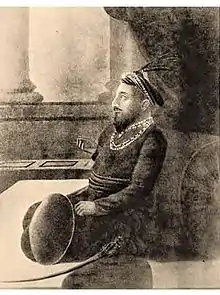 |
Ala ud-Daula | Murshid Quli Jafar Khan | 1665 | 1717– 1727 | 30 June 1727 |
 |
Mirza Asadullah | Sarfaraz Khan Bahadur | ? | 1727–1727 | April 1740 |
 |
Shuja ud-Daula | Shuja-ud-Din Muhammad Khan | 1670 | July 1727 – 26 August 1739 | 26 August 1739 |
 |
Mirza Asadullah | Sarfaraz Khan Bahadur | ? | 13 March 1739 – April 1740 | April 1740 |
 |
Husam ud-Daula | Muhammad Alivardi Khan Bahadur | 10 May 1671 | 29 April 1740 – 16 April 1756 | 16 April 1756 |
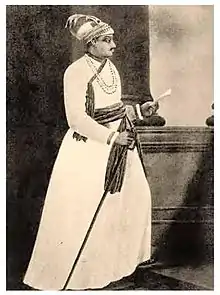 |
Siraj ud-Daulah | Mîrzâ Muhammad Sirâj-ud-Daulah | 1733 | April 1756 – 2 June 1757 | June 1757 |
_and_Mir_Miran_(right).jpg.webp) |
Ja'afar 'Ali Khan Bahadur | Mir Muhammed Jafar Ali Khan | 1691 | June 1757 – October 1760 | 17 January 1765 |
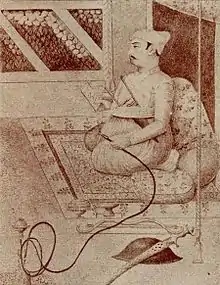 |
Itimad ud-Daulah | Mir Kasim Ali Khan Bahadur | ? | 1760–1763 | 1777 |
_and_Mir_Miran_(right).jpg.webp) |
Ja'afar 'Ali Khan Bahadur | Mir Muhammed Jafar Ali Khan | 1691 | 25 July 1763 – 17 January 1765 | 17 January 1765 |
 |
Nazam-ud-Daulah | Najimuddin Ali Khan | 1750 | 5 February 1765 – 8 May 1766 | 8 May 1766 |
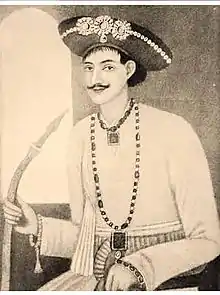 |
Saif ud-Daulah | Najabut Ali Khan | 1749 | 22 May 1766 – 10 March 1770 | 10 March 1770 |
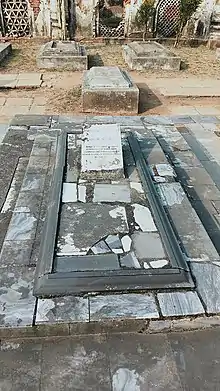 |
Ashraf Ali Khan | Before 1759 | 10 March 1770 – 24 March 1770 | 24 March 1770 | |
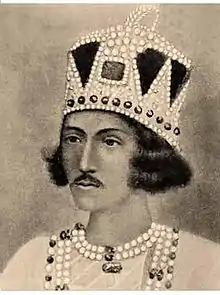 |
Mubarak ud-Daulah | Mubarak Ali Khan | 1759 | 21 March 1770 – 6 September 1793 | 6 September 1793 |
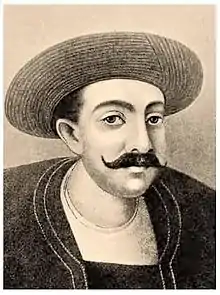 |
Azud ud-Daulah | Babar Ali Khan Bahadur | ? | 1793 – 28 April 1810 | 28 April 1810 |
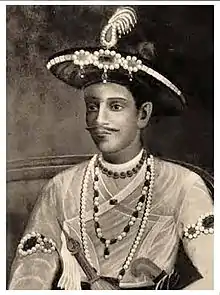 |
Ali Jah | Zain-ud-Din Ali Khan | ? | 5 June 1810 – 6 August 1821 | 6 August 1821 |
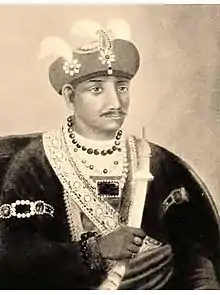 |
Walla Jah | Ahmad Ali Khan | ? | 1810 – 30 October 1824 | 30 October 1824 |
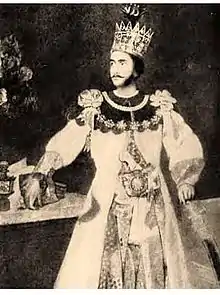 |
Humayun Jah | Mubarak Ali Khan II | 29 September 1810 | 1824 – 3 October 1838 | 3 October 1838 |
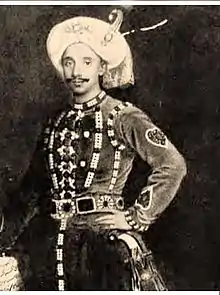 |
Feradun Jah | Mansur Ali Khan | 29 October 1830 | 29 October 1838 –1881 (abdicated) | 5 November 1884 |
Nawabs of Murshidabad
| Picture | Titular Name | Personal Name | Birth | Reign | Death |
|---|---|---|---|---|---|
| Najafi Dynasty | |||||
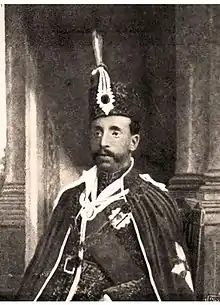 |
Ali Kadir | Syed Hassan Ali Mirza Khan Bahadur | 25 August 1846 | 17 February 1882 – 25 December 1906 | 25 December 1906[23] |
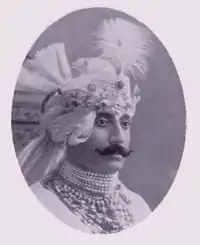 |
Amir ul-Omrah | Syed Wasif Ali Mirza Khan Bahadur | 7 January 1875 | December 1906 – 23 October 1959 | 23 October 1959[24] |
 |
Raes ud-Daulah | Syed Waris Ali Mirza Khan Bahadur | 14 November 1901 | 23 October 1959 – 20 November 1969 | 20 November 1969[25] |
| N/A | N/A | Disputed/In abeyance[26][27] | N/A | 20 November 1969 – 13 August 2014 | N/A |
 |
N/A | Syed Mohammed Abbas Ali Mirza Khan Bahadur | Circa 1942 | 13 August 2014 – Present(titular)[26][27] | N/A |
Hindu Dynasties in Bengal
Maharajas of Bankura
- Adi Malla (694 - 710)
- Jay Malla (710 - 720)
- Kalu Malla
- Kau Malla
- Jhau Malla
- Sur Malla
- Jagat Malla (994 - 1007)
- Prithwi Malla (1295 - 1319)
- Dinabandhu Malla (1334 - 1345)
- Shiv Singh Malla (1370 - 1407)
- Madan Malla (1407 - 1420)
- Durjan Malla (1420 - 1437)
- Uday Malla (1437 - 1460)
- Chandra Malla (1460 - 1501)
- Bir Malla (1501 - 1554)
- Dhari Malla (1554 - 1565)
- Hambir Malla Dev (1565 - 1620)
- Dhari Hambir Malla Dev (1620 - 1626)
- Raghunath Singha Dev (1626 - 1656)
- Bir Singha Dev (1656 - 1682)
- Bir Singha Dev II
- Durjan Singha Dev (1694)
- Raghunath Singha Dev II (1702 - 1712)
- Gopal Singha Dev (1712 - 1748)
- Chaitannya Singha Dev (1748 - 1801)
- Madhav Singh Dev (1801 - 1809)
- Gopal Singha Dev II (1809-1876)
- Ramkrishna Singha Dev(1876-1889)
- Nilmoni Singha Dev(1889-1930)
- Kalipada Singha Thakur(1930-1984)
- Parmananda De (1900–30)
Maharajas of Bhurshut
- Shivanarayan
- Maharaja Rudranarayan, Maharaja (16th century)
- Bhavashankari, Maharaja (16th century)
- Pratapnarayan, Maharaja (17th century)
- Naranarayan, Maharaja (17th century)
- Lakshminarayan, Maharaja (c.1695–1712)
Maharajas of Chandradwip
Many illustrious maharajas ruled much of East Bengal and the Sundarbans and conquered Jessore Their surname was Basu - they came to Bengal during the Sena Dynasty to conquer the Palas and take over from them. A famous literary novel was written about the Chandradwip Basu family by Tagore called Bou Thakuranis Haat and a film was made from this book.
Bhawal Estate
Rulers of Gazipur and Madhupur forest area, in central Bangladesh.
Maharajas of Koch Behar(Cooch Behar State)
- Viswa Singha
- Nara Narayan
- Lakshmi Narayan
- Harendra Narayan
- Shivendra Narayan
- Narendra Narayan
- Nripendra Narayan
- Jitendra Narayan
- Jagaddipendra Narayan
Maharajas of Jessore Kingdom
Maharajas of Nadia
- Raja Bhabananda
- Raja Sri Krishna Ray
- Raja Gopal Ray
- Raja Raghab Ray
- Maharaja Rudra Ray
- Raja Ramjiban Ray
- Raja Ramjiban Ray II
- Raja Raghuram Ray
- Raja Krishnachandra Ray 1727-1772
East India Company governors in Bengal
Governors of British East India Company in Bengal (1757–1793)
- Robert Clive 1757 – 1760
- Henry Vansittart 1760 – 1764
- Robert Clive (again) 1765 – 1766
- Harry Verelst 1767 – 1769
- John Cartier 1769 – 1772
- Warren Hastings 1772 – 1773 see below
As per the treaty of Allahabad in 1765, the British East India Company (BEIC) was given the right to collect revenue (Diwani right). From 1769, the company collected revenue from Bengal.
Governors-General of British East India Company in Bengal - Dual government (1773-1774)
Following the Regulating Act of 1773, the Governor of Bengal was officially called Governor-General of Fort William.
- Warren Hastings 1773 see above – 1774
- Charles Cornwallis 1786 – 1793
Governors-General of British East India Company in Bengal (1793–1854)
In 1793, the British East India Company abolished Nizamat, i.e. local rule by Mughal emperor- appointed Nawabs and annexed Bengal.
- Sir John Shore 1793 - 1798
- Richard Wellesley 1798 – 1805
- Charles Cornwallis 1805 – 1805
- Sir George Barlow, 1st Baronet 1805 - 1807
- Gilbert Elliot-Murray-Kynynmound, 1st Earl of Minto 1807 - 1813
- Francis Rawdon-Hastings, 1st Marquess of Hastings 1813 - 1823
- John Adam 1823 - 1823
- William Amherst, 1st Earl Amherst 1823 - 1828
- William Butterworth Bayley 1828 - 1828
- Lord William Bentinck 1828 - 1833
Governor-Generals of British East India Company (1833-1858)
As per Charter Act of 1833, the Governor-General of Bengal would be called Governor-General of India
- Lord William Bentinck 1833 - 1835
- Charles Metcalfe, 1st Baron Metcalfe 1835 - 1836
- George Eden 1836 - 1842
- Edward Law 1842 - 1844
- William Bird 1844 - 1844
- Henry Hardinge 1844 - 1848
- James Broun-Ramsay 1848 – 1856
- The Viscount Canning 1856 - 1858
British Raj Period
With the establishment of the Empire of India in 1858, the position of Governor-General was replaced with Governor-General and Viceroy of India. Calcutta, the capital of Bengal also became the capital of India. As a result, the position of Lieutenant-Governor of Bengal was established to look after provincial matters.
Lieutenant-Governors (1858–1912)
- Frederick James Halliday 1858–1859
- John Grant 1859–1862
- Sir Cecil Beadon 1862–1866
- Sir William Grey 1866–1871
- George Campbell 1871–1874
- Sir Richard Temple 1874–1877
- Sir Ashley Eden 1877–1879
- Steuart Bayley 1879–1882
- Sir Augustus Thompson 1882–1885
- Horace Cockerell 1885–1887
- Sir Steuart Bayley 1887–1890
- Charles Eliott 1890–1893
- Anthony MacDonnell 1893–1895
- Alexander Mackenzie 1895–1897
- Charles Cecil Stevens 1897–1898
- Sir John Woodburn 1898–1902
- James Bourdillon 1902–1903
- Sir Andrew Fraser 1903–1906
- Lancelot Hare 1906–1906
- Francis Slacke 1906–1908
- Sir Edward Baker 1908–1911
- Sir William Duke 1911–1912
Governors (1912–1947)
In late 1911, the Indian Government decided to move the capital to New Delhi. As a result, the Governorship of Bengal Presidency was now necessary.
| Name | Took office | Left office |
|---|---|---|
| Thomas Gibson-Carmichael, 1st Baron Carmichael | 1912 | 1917 |
| Lawrence Dundas, Earl of Ronaldshay | 1917 | 1922 |
| Victor Bulwer-Lytton, 2nd Earl of Lytton | 1922 | 1927 |
| Sir Stanley Jackson | 1927 | 1932 |
| Sir John Anderson | 1932 | 1937 |
| Michael Knatchbull, 5th Baron Brabourne | 1937 | 1938 |
| Sir John Arthur Herbert | 1939 | 1943 |
| Richard Casey | 1944 | 1946 |
| Sir Frederick Burrows | 1946 | 1947 |
Prime Minister of Bengal (1937–1947)
The Government of India Act 1935 introduced provincial autonomy in India and the position of Chief Minister or Premier of Bengal became very prominent.
Office holders
.jpg.webp)
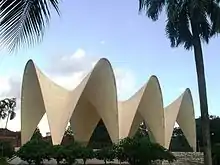
| No | Name | Image | Term(s)[28] | Party | Governor | Viceroy |
|---|---|---|---|---|---|---|
| 1 | Sher-e-Bangla A. K. Fazlul Huq | 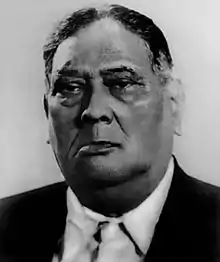 | 1 April 1937 - 1 December 1941 12 December 1941 - 29 March 1943 | Krishak Praja Party | Sir John Arthur Herbert | The Marquess of Linlithgow |
| 2 | Sir Khawaja Nazimuddin | 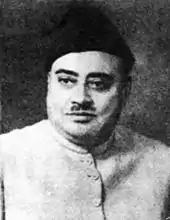 | 29 April 1943 - 31 March 1945 | Bengal Provincial Muslim League | Sir John Arthur Herbert (-1944) Sir Richard Casey (1944-) | The Marquess of Linlithgow The Viscount Wavell |
| 3 | H. S. Suhrawardy |  | 23 April 1946 - 14 August 1947 | Bengal Provincial Muslim League | Sir Richard Casey (-1946) Sir Frederick Burrows | The Viscount Wavell Earl Mountbatten |
Subsequently, all three Bengali chief ministers moved to East Pakistan, where they continued to be influential statesmen. Nazimuddin and Suhrawardy became Prime Ministers of Pakistan, while Huq served as the Chief Minister and Governor of East Pakistan.
After Independence of India and Pakistan
British colonial period ended when India and Pakistan became independent nations in 1947. Bengal fell into two parts – one in India, named West Bengal and the other part in Pakistan as East Bengal, later renamed to East Pakistan in 1955.
Governors of East Bengal (1947–1955)
| Tenure | Governor of East Bengal |
|---|---|
| 15 August 1947 - 31 March 1950 | Sir Frederick Chalmers Bourne |
| 31 March 1950 - 31 March 1953 | Sir Feroz Khan Noon |
| 31 March 1953 - 29 May 1954 | Chaudhry Khaliquzzaman |
| 29 May 1954 - May 1955 | Iskandar Ali Mirza |
| May 1955 - June 1955 | Muhammad Shahabuddin (acting) |
| June 1955 - 14 October 1955 | Amiruddin Ahmad |
Chief Minister of East Bengal (1947–1955)
| Tenure | Chief Minister of East Bengal | Political Party |
|---|---|---|
| August 1947 – September 1948 | Sir Khwaja Nazimuddin | Muslim League |
| September 1948 – April 1954 | Nurul Amin | Muslim League |
| April 1954 – 1955 | Abul Kasem Fazlul Huq | Muslim League |
Governors of East Pakistan (1955–1971)
In late 1954, the prime minister Muhammad Ali Bogra initiated the One Unit policy which resulted in East Bengal province being renamed to East Pakistan.
| Tenure | Governor of East Pakistan | Political Affiliation |
|---|---|---|
| 14 October 1955 – March 1956 | Amiruddin Ahmad | Muslim League |
| March 1956 – 13 April 1958 | A. K. Fazlul Huq | Muslim League |
| 13 April 1958 – 3 May 1958 | Hamid Ali (acting) | Awami League |
| 3 May 1958 – 10 October 1958 | Sultanuddin Ahmad | Awami League |
| 10 October 1958 – 11 April 1960 | Zakir Husain | Muslim League |
| 11 April 1960 – 11 May 1962 | Lieutenant-General Azam Khan, PA | Military Administration |
| 11 May 1962 – 25 October 1962 | Ghulam Faruque | Independent |
| 25 October 1962 – 23 March 1969 | Abdul Monem Khan | Civil Administration |
| 23 March 1969 – 25 March 1969 | Mirza Nurul Huda | Civil Administration |
| 25 March 1969 – 23 August 1969 | Major-General Muzaffaruddin,[29] PA | Military Administration |
| 23 August 1969 – 1 September 1969 | Lieutenant-General Sahabzada Yaqub Khan, PA | Military Administration |
| 1 September 1969 – 7 March 1971 | Vice-Admiral Syed Mohammad Ahsan, PN | Military Administration |
| 7 March 1971 – 6 April 1971 | Lieutenant-General Sahabzada Yaqub Khan, PA | Military Administration |
| 6 April 1971 – 31 August 1971 | Lieutenant-General Tikka Khan, PA | Military Administration |
| 31 August 1971 – 14 December 1971 | Abdul Motaleb Malik | Independent |
| 14 December 1971 – 16 December 1971 | Lieutenant-General Amir Abdullah Khan Niazi, PA | Military Administration |
Chief Minister of East Pakistan (1955–1971)
| Tenure | Chief Minister of East Pakistan | Political Party |
|---|---|---|
| August 1955 – September 1956 | Abu Hussain Sarkar | Krishan Sramik Party |
| September 1956 – March 1958 | Ataur Rahman Khan | Awami League |
| March 1958 | Abu Hussain Sarkar | Krishan Sramik Party |
| March 1958 – 18 June 1958 | Ataur Rahman Khan | Awami League |
| 18 June 1958 – 22 June 1958 | Abu Hussain Sarkar | Krishan Sramik Party |
| 22 June 1958 – 25 August 1958 | Governor's Rule | |
| 25 August 1958 – 7 October 1958 | Ataur Rahman Khan | Awami League |
On 7 October 1958, the post of Chief Minister of East Pakistan was abolished. And after the independence of Bangladesh on 16 December 1971, the Province of East Pakistan was dissolved.
Governors of West Bengal
| Sl. No. | Name | Took office | Left office |
|---|---|---|---|
| 1 | Chakravarthi Rajagopalachari | 15 August 1947 | 21 June 1948 |
| 2 | Kailash Nath Katju | 21 June 1948 | 1 November 1951 |
| 3 | Harendra Coomar Mookerjee | 1 November 1951 | 8 August 1956 |
| 4 | Phani Bhusan Chakravartti | 8 August 1956 | 3 November 1956 |
| 5 | Padmaja Naidu | 3 November 1956 | 1 June 1967 |
| 6 | Dharma Vira | 1 June 1967 | 1 April 1969 |
| 7 | Deep Narayan Sinha (acting) | 1 April 1969 | 19 September 1969 |
| 8 | Shanti Swaroop Dhavan | 19 September 1969 | 21 August 1971 |
| 9 | Anthony Lancelot Dias | 21 August 1971 | 6 November 1979 |
| 10 | Tribhuvana Narayana Singh | 6 November 1979 | 12 September 1981 |
| 11 | Bhairab Dutt Pande | 12 September 1981 | 10 October 1983 |
| 12 | Anant Prasad Sharma | 10 October 1983 | 16 August 1984 |
| 13 | Satish Chandra (acting) | 16 August 1984 | 1 October 1984 |
| 14 | Uma Shankar Dikshit | 1 October 1984 | 12 August 1986 |
| 15 | Saiyid Nurul Hasan | 12 August 1986 | 20 March 1989 |
| 16 | T. V. Rajeswar | 20 March 1989 | 7 February 1990 |
| 17 | Saiyid Nurul Hasan | 7 February 1990 | 12 July 1993 |
| 18 | B. Satyanarayan Reddy (additional charge) | 13 July 1993 | 14 August 1993 |
| 18 | K. V. Raghunatha Reddy | 14 August 1993 | 27 April 1998 |
| 20 | Akhlaqur Rahman Kidwai | 27 April 1998 | 18 May 1999 |
| 21 | Shyamal Kumar Sen | 18 May 1999 | 4 December 1999 |
| 22 | Viren J. Shah | 4 December 1999 | 14 December 2004 |
| 23 | Gopalkrishna Gandhi | 14 December 2004 | 14 December 2009 |
| 24 | Devanand Konwar (additional charge) | 14 December 2009 | 23 January 2010 |
| 25 | M.K. Narayanan | 24 January 2010 | 30 June 2014 |
| 26 | D. Y. Patil (acting charge)[30] | 3 July 2014 | 17 July 2014 |
| 27 | Keshari Nath Tripathi | 24 July 2014 | 29 July 2019 |
| 28 | Jagdeep Dhankar[31] | 30 July 2019 | Incumbent |
Chief Ministers of West Bengal
| Key: | INC Indian National Congress |
BC-UF Bangla Congress |
CPI(M) Communist Party of India (Marxist) |
AITC All India Trinamool Congress |
|---|
| # | Name | Took Office | Left Office | Political Party |
| 1 | Prafulla Chandra Ghosh | 15 August 1947 | 14 January 1948 | Indian National Congress |
| 2 | Bidhan Chandra Roy | 14 January 1948 | 1 July 1962 | Indian National Congress |
| President's rule | 1 July 1962 | 8 July 1962 | ||
| 3 | Prafulla Chandra Sen | 8 July 1962 | 15 March 1967 | Indian National Congress |
| 4 | Ajoy Kumar Mukherjee | 15 March 1967 | 2 November 1967 | Bangla Congress in United Front |
| 5 | Prafulla Chandra Ghosh | 2 November 1967 | 20 February 1968 | Nonparty in Progressive Democratic Alliance Front |
| President's rule | 20 February 1968 | 25 February 1969 | ||
| 6 | Ajoy Kumar Mukherjee | 25 February 1969 | 19 March 1970 | Bangla Congress in United Front |
| President's rule | 19 March 1970 | 2 April 1971 | ||
| 7 | Ajoy Kumar Mukherjee | 2 April 1971 | 28 June 1971 | Indian National Congress in coalition |
| President's rule | 28 June 1971 | 19 March 1972 | ||
| 8 | Siddhartha Shankar Ray | 19 March 1972 | 21 June 1977 | Indian National Congress |
| 9 | Jyoti Basu | 21 June 1977 | 6 November 2000 | Communist Party of India (Marxist) in Left Front |
| 10 | Buddhadeb Bhattacharya | 6 November 2000 | 13 May 2011 | Communist Party of India (Marxist) in Left Front |
| 11 | Mamata Banerjee | 20 May 2011 | Incumbent | All India Trinamool Congress |
After independence of Bangladesh
East Pakistan seceded from West Pakistan on 16 December 1971 after the end of Bangladesh Liberation War and was named Bangladesh as an independent nation.
The President was the executive Head of state of Bangladesh during Presidential system of government from 1975 to 1991. Thereafter, the Prime Minister is the executive head of government of this parliamentary republic while the President is the ceremonial Head of state, elected by the parliament.
Key
- Political parties
- Other factions
- Status
- Acting President
Presidents
| Name (Birth–Death) |
Portrait | Elected | Term of office | Time in office | Party | ||
|---|---|---|---|---|---|---|---|
| Sheikh Mujibur Rahman (1920–1975)[lower-alpha 1] |
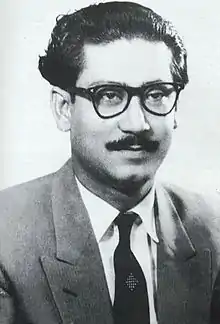 |
— | 17 April 1971 | 12 January 1972 | 270 days | Bangladesh Awami League | |
| Syed Nazrul Islam (1925–1975)[lower-alpha 2] |
 |
— | 17 April 1971 | 12 January 1972 | 270 days | Bangladesh Awami League | |
| Abu Sayeed Chowdhury (1921–1987) |
 |
— | 12 January 1972 | 24 December 1973 | 1 year, 346 days | Bangladesh Awami League | |
| Mohammad Mohammadullah (1921–1999) |
 |
— | 24 December 1973 | 27 January 1974 | 1 year, 32 days | Bangladesh Awami League | |
| 1974 | 27 January 1974 | 25 January 1975 | |||||
| Sheikh Mujibur Rahman (1920–1975) |
 |
— | 25 January 1975 | 15 August 1975 (assassinated in a coup d'état.) |
202 days | BAKSAL | |
| Khondaker Mostaq Ahmad (1918–1996) |
 |
— | 15 August 1975 | 6 November 1975 (deposed.) |
83 days | Bangladesh Awami League | |
| Abu Sadat Mohammad Sayem (1916–1997)[lower-alpha 3] |
 |
— | 6 November 1975 | 21 April 1977 | 1 year, 166 days | Bangladesh Awami League | |
| Ziaur Rahman (1936–1981)[lower-alpha 4] |
 |
1977[lower-alpha 5] 1978[lower-alpha 6] |
21 April 1977 | 30 May 1981 (assassinated.) |
4 years, 39 days | Military / Bangladesh Nationalist Party | |
| Abdus Sattar (1906–1985) |
 |
— | 30 May 1981 | 20 November 1981 | 298 days | Bangladesh Nationalist Party | |
| 1981[lower-alpha 6] | 20 November 1981 | 24 March 1982 (deposed.) | |||||
| Post vacant (24 – 27 March 1982)[lower-alpha 7] | |||||||
| Ahsanuddin Chowdhury (1915–2001) |
 |
— | 27 March 1982 | 10 December 1983 | 1 year, 258 days | Independent | |
| Hussain Muhammad Ershad (1930–2019)[lower-alpha 8] |
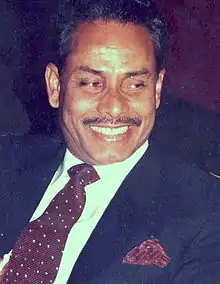 |
1985[lower-alpha 5] 1986[lower-alpha 6] |
11 December 1983 | 6 December 1990 | 6 years, 360 days | Military / Jatiya Party | |
| Shahabuddin Ahmed (born 1930) |
 |
— | 6 December 1990 | 10 October 1991 | 308 days | Independent | |
| Abdur Rahman Biswas (1926–2017) |
 |
1991 | 10 October 1991 | 9 October 1996 | 4 years, 365 days | Bangladesh Nationalist Party | |
| Shahabuddin Ahmed (born 1930) |
 |
1996 | 9 October 1996 | 14 November 2001 | 5 years, 36 days | Independent | |
| Badruddoza Chowdhury (born 1932) |
 |
2001 | 14 November 2001 | 21 June 2002 | 219 days | Bangladesh Nationalist Party | |
| Muhammad Jamiruddin Sircar (born 1931) |
 |
— | 21 June 2002 | 6 September 2002 | 77 days | Bangladesh Nationalist Party | |
| Iajuddin Ahmed (1931–2012) |
 |
2002 | 6 September 2002 | 12 February 2009 | 6 years, 159 days | Independent | |
| Zillur Rahman (1929–2013) |
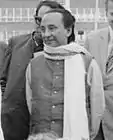 |
2009 | 12 February 2009 | 20 March 2013 (died in office.) |
4 years, 36 days | Bangladesh Awami League | |
| Abdul Hamid (born 1944)[lower-alpha 9] |
.jpg.webp) |
— | 14 March 2013 | 24 April 2013 | 7 years, 307 days | Bangladesh Awami League | |
| 2013 | 24 April 2013 | 24 April 2018 | |||||
| 2018 | 24 April 2018 | Incumbent | |||||
Prime Ministers of Bangladesh
| Name (Birth–Death) |
Portrait | Election | Term of office | Tenure | Party | ||
|---|---|---|---|---|---|---|---|
| Tajuddin Ahmad (1925–1975) |
 |
— | 11 April 1971 | 12 January 1972 | 276 days | Bangladesh Awami League | |
| Sheikh Mujibur Rahman (1920–1975) |
 |
1973 | 12 January 1972 | 25 January 1975 | 3 years, 13 days | Bangladesh Awami League | |
| Muhammad Mansur Ali (1919–1975) |
 |
— | 25 January 1975 | 15 August 1975 (deposed.) |
202 days | BAKSAL | |
| Post abolished (15 August 1975 – 29 June 1978) | |||||||
| Mashiur Rahman (1924–1979)[lower-alpha 10] |
 |
— | 29 June 1978 | 12 March 1979 (died in office.) |
256 days | Bangladesh Nationalist Party | |
| Shah Azizur Rahman (1925–1988) |
 |
1979 | 15 April 1979 | 24 March 1982 (deposed.) |
2 years, 343 days | Bangladesh Nationalist Party | |
| Post abolished (24 March 1982 – 30 March 1984) | |||||||
| Ataur Rahman Khan (1907–1991) |
 |
— | 30 March 1984 | 9 July 1986 | 2 years, 101 days | Jatiya Party | |
| Mizanur Rahman Chowdhury (1928–2006) |
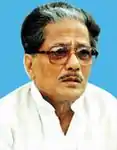 |
1986 | 9 July 1986 | 27 March 1988 | 1 year, 262 days | Jatiya Party | |
| Moudud Ahmed (born 1940) |
 |
1988 | 27 March 1988 | 12 August 1989 | 1 year, 138 days | Jatiya Party | |
| Kazi Zafar Ahmed (1939–2015) |
 |
— | 12 August 1989 | 6 December 1990 | 1 year, 116 days | Jatiya Party | |
| Post abolished (6 December 1990 – 20 March 1991) | |||||||
| Khaleda Zia (born 1945) |
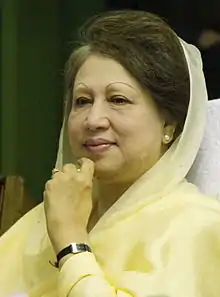 |
1991 1996 (Feb) |
20 March 1991 | 30 March 1996 | 5 years, 10 days | Bangladesh Nationalist Party | |
| Muhammad Habibur Rahman (1928–2014) |
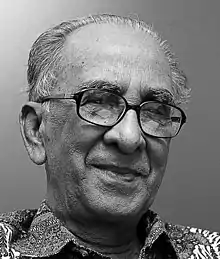 |
— | 30 March 1996 | 23 June 1996 | 85 days | Independent | |
| Sheikh Hasina (born 1947) |
_(cropped).jpg.webp) |
1996 (Jun) | 23 June 1996 | 15 July 2001 | 5 years, 22 days | Bangladesh Awami League | |
| Latifur Rahman (1936–2017) |
 |
— | 15 July 2001 | 10 October 2001 | 87 days | Independent | |
| Khaleda Zia (born 1945) |
 |
2001 | 10 October 2001 | 29 October 2006 | 5 years, 19 days | Bangladesh Nationalist Party | |
| Iajuddin Ahmed (1931–2012)[lower-alpha 11] |
 |
— | 29 October 2006 | 11 January 2007 | 74 days | Independent | |
| Fazlul Haque (born 1938)[lower-alpha 12] |
 |
— | 11 January 2007 | 12 January 2007 | 1 day | Independent | |
| Fakhruddin Ahmed (born 1940) |
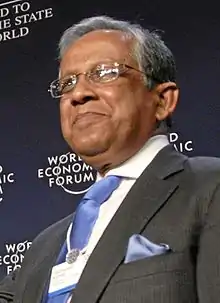 |
— | 12 January 2007 | 6 January 2009 | 1 year, 360 days | Independent | |
| Sheikh Hasina (born 1947) |
_(cropped).jpg.webp) |
2008 2014 2018 |
6 January 2009 | Incumbent | 12 years, 9 days | Bangladesh Awami League | |
See more
Notes
- Pakistani prisoner to 8 January 1972.
- Acting for Sheikh Mujibur Rahman.
- Also Chief Martial Law Administrator (24 August 1975 – 4 November 1975 and 7 November 1975 – 29 November 1976).
- Also Chief Martial Law Administrator (29 November 1976 – 6 April 1979).
- Referendum.
- Direct election.
- During this period, Chief of Army Staff Lt. Gen. Hussain Muhammad Ershad served as Chief Martial Law Administrator and de facto head of state.
- Served as Chief Martial Law Administrator until 30 March 1984.
- Acting for Zillur Rahman until 20 March 2013.
- Senior Minister.
- Simultaneously served as President.
- Acting Chief Adviser.
References
- The preaching of Islam: a history of the propagation of the Muslim faith By Sir Thomas Walker Arnold, pp. 227-228
- Majumdar, Dr. R.C., History of Mediaeval Bengal, First published 1973, Reprint 2006,Tulshi Prakashani, Kolkata, ISBN 81-89118-06-4
- Sen, Sailendra (2013). A Textbook of Medieval Indian History. Primus Books. pp. 68–102. ISBN 978-9-38060-734-4.
- Nanda, J. N (2005). Bengal: the unique state. Concept Publishing Company. p. 10. 2005. ISBN 978-81-8069-149-2.
Bengal [...] was rich in the production and export of grain, salt, fruit, liquors and wines, precious metals, and ornaments besides the output of its handlooms in silk and cotton. Europe referred to Bengal as the richest country to trade with.
- "The paradise of nations | Dhaka Tribune". Archive.dhakatribune.com. 20 December 2014. Archived from the original on 16 December 2017. Retrieved 7 November 2016.
- M. Shahid Alam (2016). Poverty From The Wealth of Nations: Integration and Polarization in the Global Economy since 1760. Springer Science+Business Media. p. 32. ISBN 978-0-333-98564-9.
- Khandker, Hissam (31 July 2015). "Which India is claiming to have been colonised?". The Daily Star (Op-ed).
- Lex Heerma van Voss; Els Hiemstra-Kuperus; Elise van Nederveen Meerkerk (2010). "The Long Globalization and Textile Producers in India". The Ashgate Companion to the History of Textile Workers, 1650–2000. Ashgate Publishing. p. 255. ISBN 9780754664284.
- Ray, Krishnendu (2012). "Khadga Dynasty". In Islam, Sirajul; Jamal, Ahmed A. (eds.). Banglapedia: National Encyclopedia of Bangladesh (Second ed.). Asiatic Society of Bangladesh.
- Dasgupta, Biswas & Mallik 2009, p. 30.
- Malabhum, Bishnupur-Chandra, Manoranjan; 2004; Kolkata. Deys Publishing ISBN 8129500442
- Mallik, Abhaya Pada (1921). History of Bishnupur-Raj: An Ancient Kingdom of West Bengal (the University of Michigan ed.). Calcutta. pp. 128–130. Retrieved 11 March 2016.
- Dilip Kumar Ganguly (1994). Ancient India, History and Archaeology. Abhinav. pp. 33–41. ISBN 978-81-7017-304-5.
- Susan L. Huntington (1984). The "Påala-Sena" Schools of Sculpture. Brill Archive. pp. 32–39. ISBN 90-04-06856-2.
- R. C. Majumdar (1971). History of Ancient Bengal. G. Bharadwaj. p. 161–162.
- Abdul Momin Chowdhury (1967). Dynastic history of Bengal, c. 750-1200 CE. Asiatic Society of Pakistan. pp. 272–273.
- Bindeshwari Prasad Sinha (1977). Dynastic History of Magadha, Cir. 450–1200 A.D. Abhinav Publications. pp. 253–. ISBN 978-81-7017-059-4.
- Dineshchandra Sircar (1975–76). "Indological Notes - R.C. Majumdar's Chronology of the Pala Kings". Journal of Ancient Indian History. IX: 209–10.
- Ahmed, ABM Shamsuddin (2012). "Iltutmish". In Islam, Sirajul; Jamal, Ahmed A. (eds.). Banglapedia: National Encyclopedia of Bangladesh (Second ed.). Asiatic Society of Bangladesh.
- Encyclopedia Of Bangladesh (Set Of 30 Vols.) By Nagendra Kr. Singh
- Sarkar, Jadunath (1984, reprint 1994). A History of Jaipur, New Delhi: Orient Longman ISBN 81-250-0333-9, pp.86–87
- Karim, Abdul (2012). "Muhammad Azam, Prince". In Islam, Sirajul; Jamal, Ahmed A. (eds.). Banglapedia: National Encyclopedia of Bangladesh (Second ed.). Asiatic Society of Bangladesh.
- Paul, Gautam. "Murshidabad History - Hassan Ali". murshidabad.net. Archived from the original on 1 September 2016. Retrieved 9 October 2016.
- Company, East India (1807). Papers Presented to the House of Commons Concerning the Late Nabob of the Carnatic. p. 118.
- Paul, Gautam. "Murshidabad History - Waresh Ali". murshidabad.net. Archived from the original on 22 March 2017. Retrieved 9 October 2016.
- Mahato, Sukumar (20 August 2014). "Murshidabad gets a Nawab again, but fight for assets ahead". The Times of India. Archived from the original on 26 April 2015. Retrieved 14 June 2015.
- "Portrait of an accidental Nawab". The Times of India. 22 August 2014. Archived from the original on 23 August 2014. Retrieved 14 June 2015.
- "Premier of Bengal". West Bengal Legislative Assembly. Archived from the original on 14 July 2014.
- (acting martial law administrator and governor as he was the GOC 14th Infantry Division)
- "Dr D y Patil appointed West Bengal's acting Governor". The Economic Times. 3 July 2014.
- "Senior Advocate Jagdeep Dhankhar Made West Bengal Governor". 20 July 2019.
Sources and external links
- Dasgupta, Gautam Kumar; Biswas, Samira; Mallik, Rabiranjan (2009). Heritage Tourism: An Anthropological Journey to Bishnupur. A Mittal Publication. p. 21. ISBN 978-8183242943.
- Islam, Sirajul (2012). "Subahdar". In Islam, Sirajul; Jamal, Ahmed A. (eds.). Banglapedia: National Encyclopedia of Bangladesh (Second ed.). Asiatic Society of Bangladesh.
- KingListsFarEast